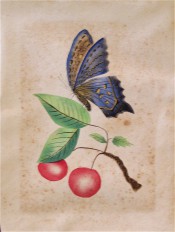Prunus avium L.
Tree with horizontally peeling bark, oval to ovate toothed leaves, and umbles of several white flowers, opening with the leaves in spring, followed by round, edible blackish-red fruits. To 9m. [RHSD, Hortus, Hilliers’].
Horticultural & Botanical History
The sweet cherries of commerce are mostly derived from this species, the sour cherries, such as the ‘Morello’ being mostly derived from Prunus cerasus L., a very similar tree, native of south east Europe to west Asia.
‘Two species of Cherry, both wild in Britain, appear to have give origin to the cultivated varieties, though many of the latter have been imported from abroad, some in very early times, for it is said that the Romans planted them here about A.D. 100, having themselves obtained varieties from Asia Minor about 70 B.C. The Sweet or Dessert Cherries have arisen from Prunus avium and fall into two groups, the Bigarreaus with firm-fleshed fruits and the Geans with tender-fleshed fruits. Prunus cerasus has given the Sour or Culinary Cherries, all of which, with the Dukes, are excellent for cooking and for bottling, and some of which, like the Morello, are preserved in Brandy. Of the Sour cherries those which have black fruits are known as Morellos, those with red fruits as Amarelles. The Dukes [sometimes called Prunus avium var. regalis], probably derived from the crossing of P. avium and P. cerasus, are intermediate between the Sour and Sweet Cherries and are useful for both dessert and culinary purposes.’ [RHSD]. Cherries had probably been cultivated in Asia for several centuries before being adopted by the Romans.
History at Camden Park
Each of the 21 varieties of cherry described in the Hortus has a separate entry. With each entry the Latin binomial is given followed by the varietal name, for example, Prunus avium ‘May Duke’. Other names by which this cherry is known, or has been known in the past, are given under synonyms. Under Common Name they are described as Sweet Cherry or Culinary Cherry, sometimes both. All descriptions are taken from contemporary literature. With most varieties the assumption is that they are largely or entirely derived from Prunus avium L. Exceptions are made for sour cherries which are held to be varieties of Prunus cerasus L.
Notes
Published Apr 22, 2010 - 04:26 PM | Last updated Jul 23, 2011 - 05:16 PM

19th century water colour | This painting, from the Camden district, is reproduced by courtesy of Pacita Alexander.
| Family | Rosaceae |
|---|---|
| Category | |
| Region of origin | Europe, including Britain, to west Asia |
| Synonyms | |
| Common Name | Sweet Cherry, Wild Cherry, Gean, Mazzard |
| Name in the Camden Park Record | Cherry
|
| Confidence level | high |